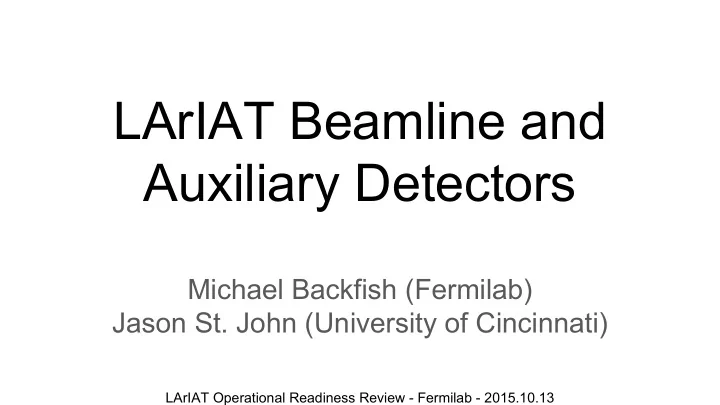

LArIAT Beamline and Auxiliary Detectors Michael Backfish (Fermilab) Jason St. John (University of Cincinnati) LArIAT Operational Readiness Review - Fermilab - 2015.10.13
Outline 1. Accelerator & Beamline a. Primary b. Secondary c. Tertiary 2. Beamline Challenges -----------Into the Experimental Hall----------- 3. Tertiary Beam & Instrumentation a. Collimators, Analyzing Magnets, Geometry b. Slow control and monitoring c. Beam Instrumentation and performance 2
Accelerator Overview (Mseps) (FSeps) 3
120 GeV Primary Beam Target and Shielding Copper Target 4
Secondary Beamline 4-80 GeV 5
MCenter Beam Profiles 6
Main Injector Bunch Structure 7
Intensity Variations Throughout the Spill ● QXR feedback loop tuning and quadrupole tuning is needed for most intensity variations within the Main Injector ● Momentum variations throughout the cycle along with dispersion in the beamline can cause position variations across either split or on the primary beam target ● Power supply regulation problems can cause undesired steering throughout the cycle ● Outside temperature ● Variations in line voltage 8
Unexpected Challenges of the test beamline TPC Drift time 350 uSec!!!! ● 11 uSec per Main Injector orbit ● 588 Buckets per Main Injector Orbit ● 18709 buckets within a 350 uSec Drift time Particles Can Overwhelm the TPC!!!! 9
Solving it Together ● Lariat has installed a system of scintillators including a portable system that can be located in various temporary locations which provide immediate feedback to Accelerator Division experts and operators. ● F:MC7U09 Lariat Cosmic Accidental detector (to minimize) F:MC7U10 Lariat Tertiary beam halo detector (to minimize) F:MC7U11 Lariat TPC Readout Trigger (to maximize) F:MC7U12 Lariat Fast Trigger (to maximize) ● Strong relationship between operations and Lariat 10
Example of Incremental Progress Open Up the Momentum Collimator coupled with a small tweak in Focus using 2 Quads Increased MC7U11 and U12 Without increasing unwanted signals 11
Future Improvements Idea credit goes fully to Doug Jensen Blue = air Blue = air Blue = air FLUX Here FLUX = 3.204E-09 mu/cm^2 FLUX = 1.279E-12 mu/cm^2 Comparison of FLUX in TPC region of MC7using MARS runs with 120,000 Protons on Target 12
Plans are Underway to Test Additional Shielding Portable halo counter to position in secondary beam line hall for measurements 13
Into the Experimental Hall 14
Tertiary Beamline - Installation & Safety Checks Installation at FTBF MC-7 allowed dry run (no TPC, no cryostat) - Characterized beam - Commissioned instruments - TPC and cryosystem got full focus when commissioned 15
Tertiary Beamline Aerogel collimator Cu target counters Time of flight μ range scintillators stack Cryostat & TPC Secondary beam 8-64 GeV π ± Multi-wire proportional μ punch- Cosmic Bending chambers through Paddles dipole magnets (MWPCs) paddles 16 Signals sent to trigger logic and to data stream.
Tertiary Beamline Synoptic - product of Fermilab 17
Tertiary Beamline Access to control panels Out-of-range indication 18
Tertiary Beamline - monitoring Detailed monitoring by subsystem to understand alarms ↑ TPC Cathode Voltage Monitoring ← Time of Flight PMTs ACNET control where possible Analyzing Magnets→ ← Wire Chambers 19
Tertiary Beamline MWPCs + bending magnet - Charge-selected beam 200 - 1200 MeV/c - Single-particle momentum measurements Downstream MWPCs Upstream MWPCs Δθ Momentum windows in J. St. John excellent agreement with simulation 20
Tertiary Beamline MWPCs + bending magnet I.Nutini Full and Half momentum settings/magnet currents cover MicroBooNE neutrino event secondary momentum range 21
Tertiary Beamline Time of flight (TOF) for separation between π ’s/ μ ’s π / μ and protons ~2:1 ratio of π / µ to p J. Ho p J. Ho p K π/μ TOF vs reconstructed momentum 22
Tertiary Beamline Aerogel Cherenkov counters for further PID π vs. μ discrimination Effective for TPC-contained Fast E. Iwai π/µ range: 230-400 MeV/c particles n=1.11 n=1.057 Aerogel Aerogel µ π µ π 200-300 MeV/c Slow µ π µ π particles 300-400 MeV/c 23
Tertiary Beamline Muon range stack for discrimination of through- going muons/pions Effective for high-p π/µ range: 400+ MeV/c Some commissioning still π +/- ongoing μ +/- 24
Tertiary Beamline Cosmic tagger paddles for triggering on diagonal cosmic-ray muons ▪ April 30, 2015 – TPC turned on, first cosmic-triggered track! 25
Conclusion The beamline is ready and has been demonstrated to produce physics-quality beam. This is true of the beamline instruments as well. Passed Operational Readiness Checks following first installation and following each significant change along the way. Extensive, helpful interaction with AD, BD, PPD, FTBF, and ND. Resources provided by the lab: - ACNET, IFIX, Synoptic, Cryo engineering, Cryo controls, engineering & technician time The necessary detectors are in place for triggering online and event-by-event particle ID offline. Already performing well. 26
27
Tertiary Beamline - monitoring cryostat & TPC 28
Tertiary Beamline n=1.11 n=1.057 Aerogel Aerogel 200-300 MeV/c µ π µ π 300-400 MeV/c µ π µ π 29
Recommend
More recommend